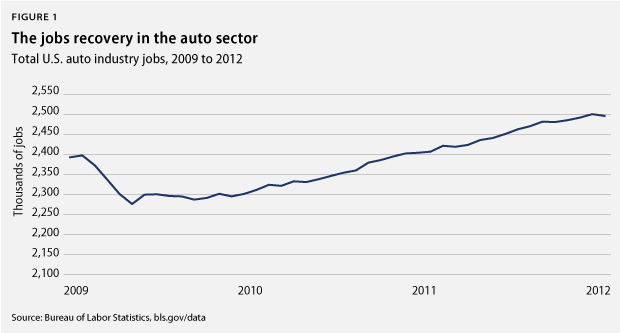The financial crisis of 2008 battered the U.S. automobile industry and endangered two of the nation’s largest automakers, General Motors Co. and Chrysler Group LLC. “If GM and Chrysler would have gone into free-fall bankruptcy, they would have taken the supply base down and taken the industry down,” Ford President and CEO Alan Mulally said in October 2010, “plus maybe turned the U.S. recession into a depression.”
To prevent the collapse, the federal government provided GM and Chrysler with financial support in return for the fundamental restructuring of their businesses. As a direct result of the auto rescue, the U.S. auto industry is again a thriving source of hundreds of thousands of good jobs. Two charts tell the tale.

Here are the details by the numbers:
- More than 1 million: Jobs saved by the auto rescue.
- $85 billion: Total spent by the U.S. government on the auto rescue.
- $60 billion: Amount the government will likely recover.
- $7.2 billion: Savings to taxpayers from reduced unemployment, Social Security, and other benefits in 2009 and 2010.
- $97 billion: Estimated losses in personal incomes prevented by the auto rescue.
- 26 percent: Remaining stake (of the initial 61 percent stake) held in GM by the government.
- 0: Number of Chrysler shares currently held by the government.
- 167,000: Number of jobs the automakers and their suppliers are forecasted to add by 2015.
- 2.5 million: Number of people employed by the U.S. auto industry today, up from 2.3 million in August 2009.
- 3.3 million: Cars and light trucks sold by GM and Chrysler in the past 12 months, up from 2.9 million in the previous period.
Logan Timmerhoff is an Economic Policy intern at the Center for American Progress.